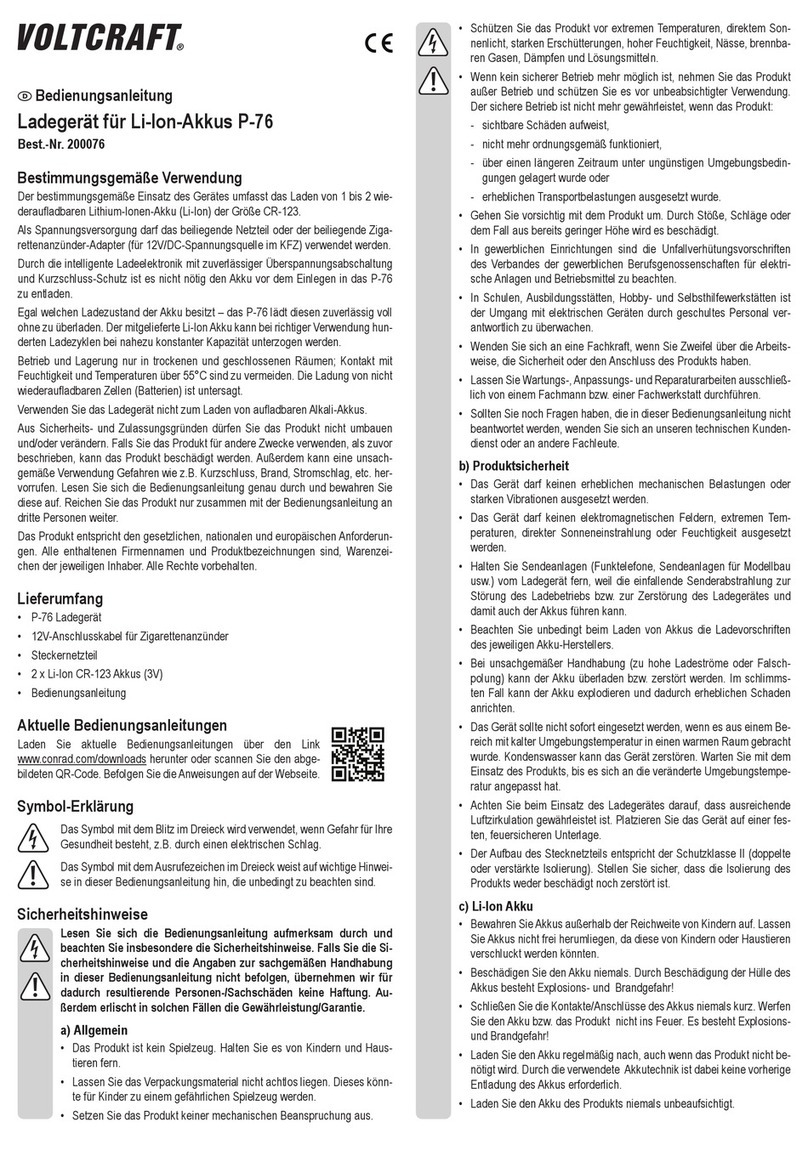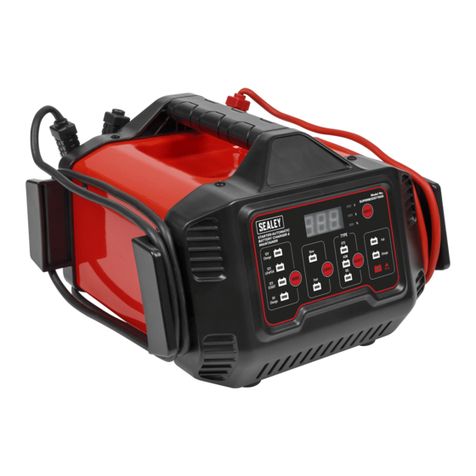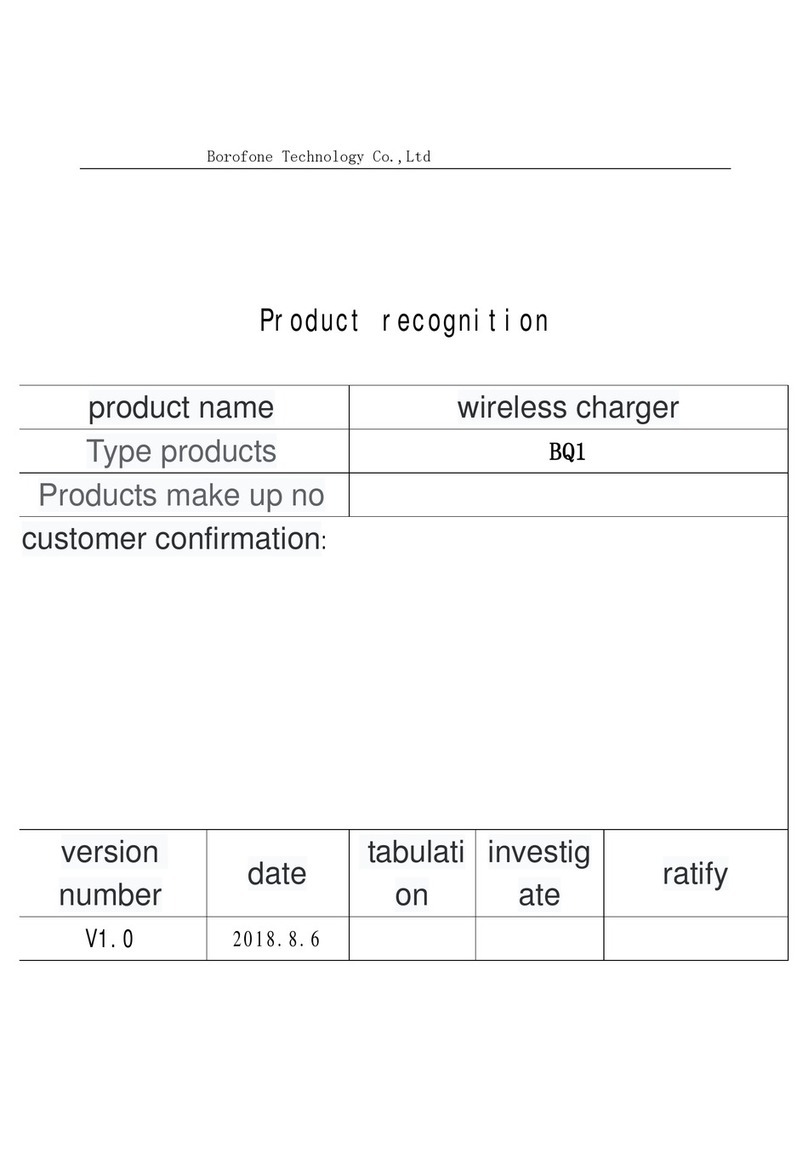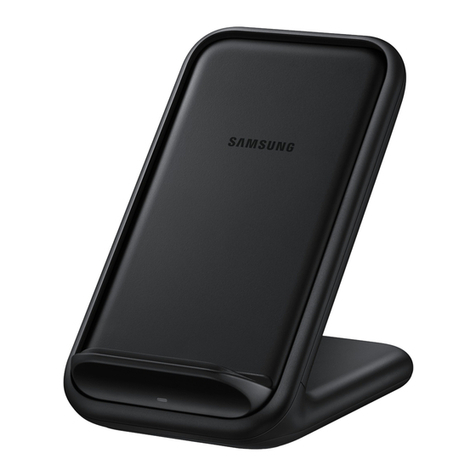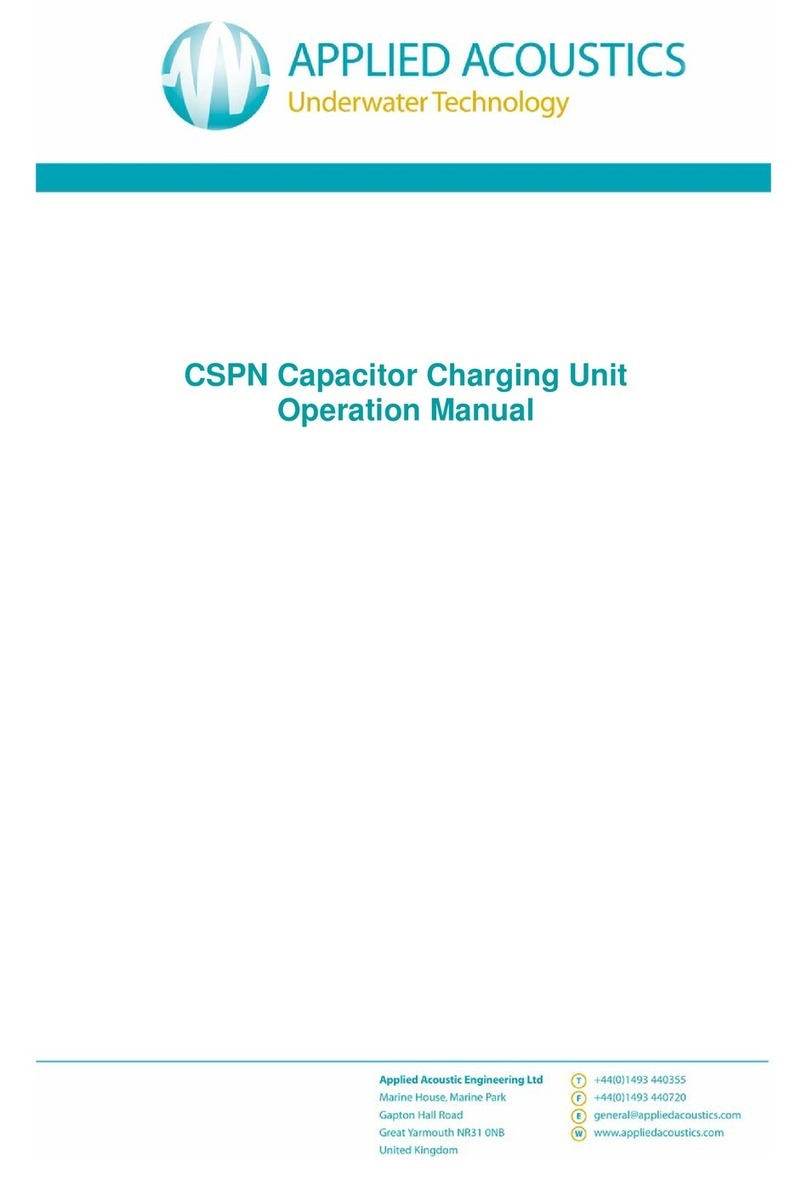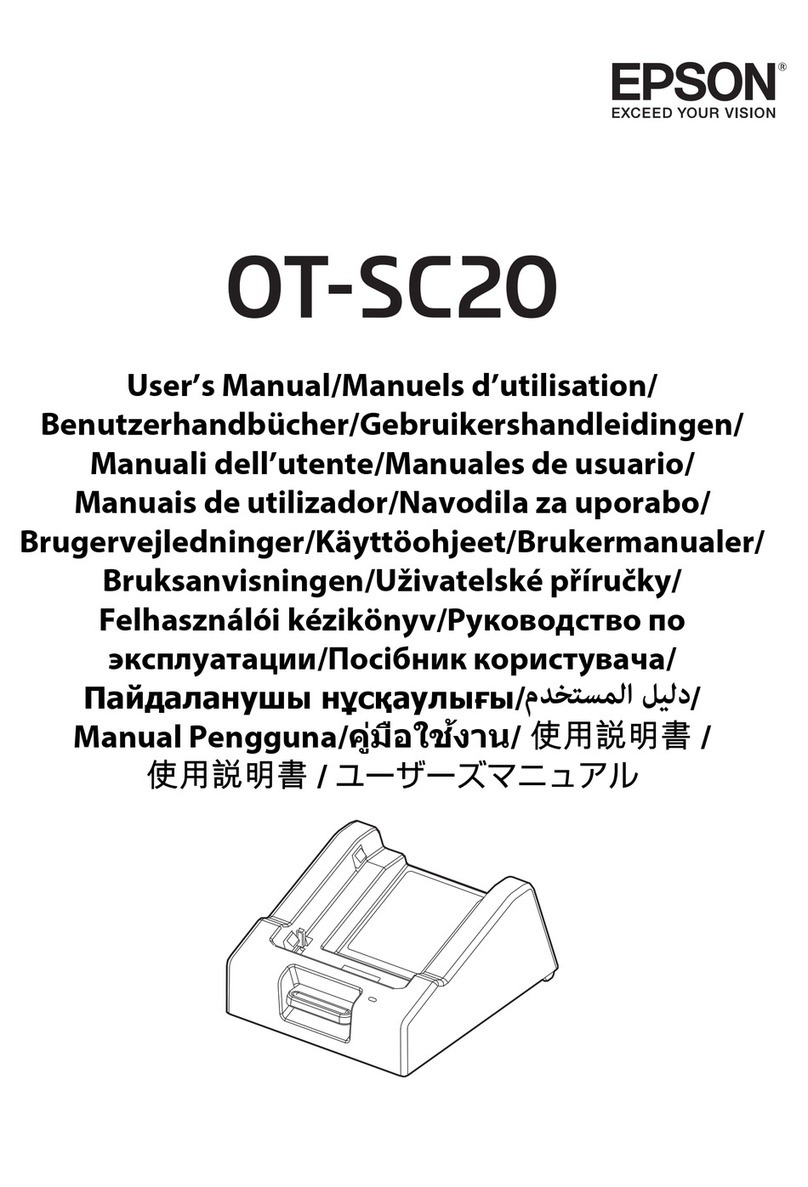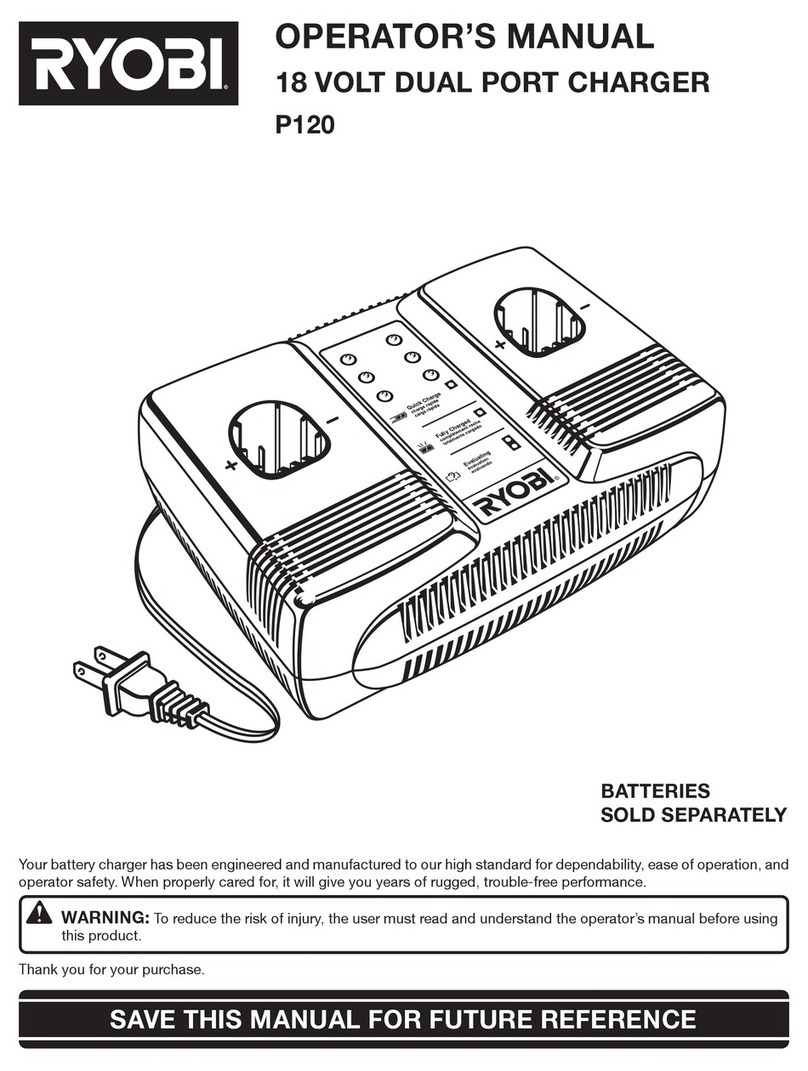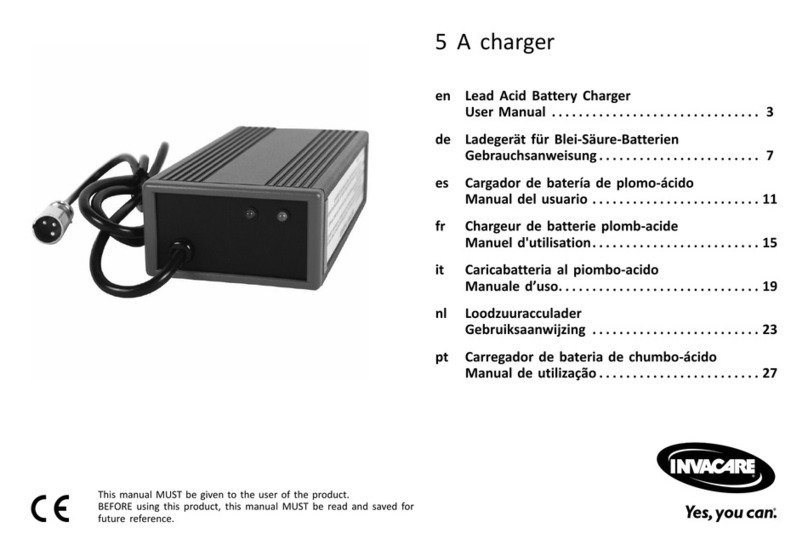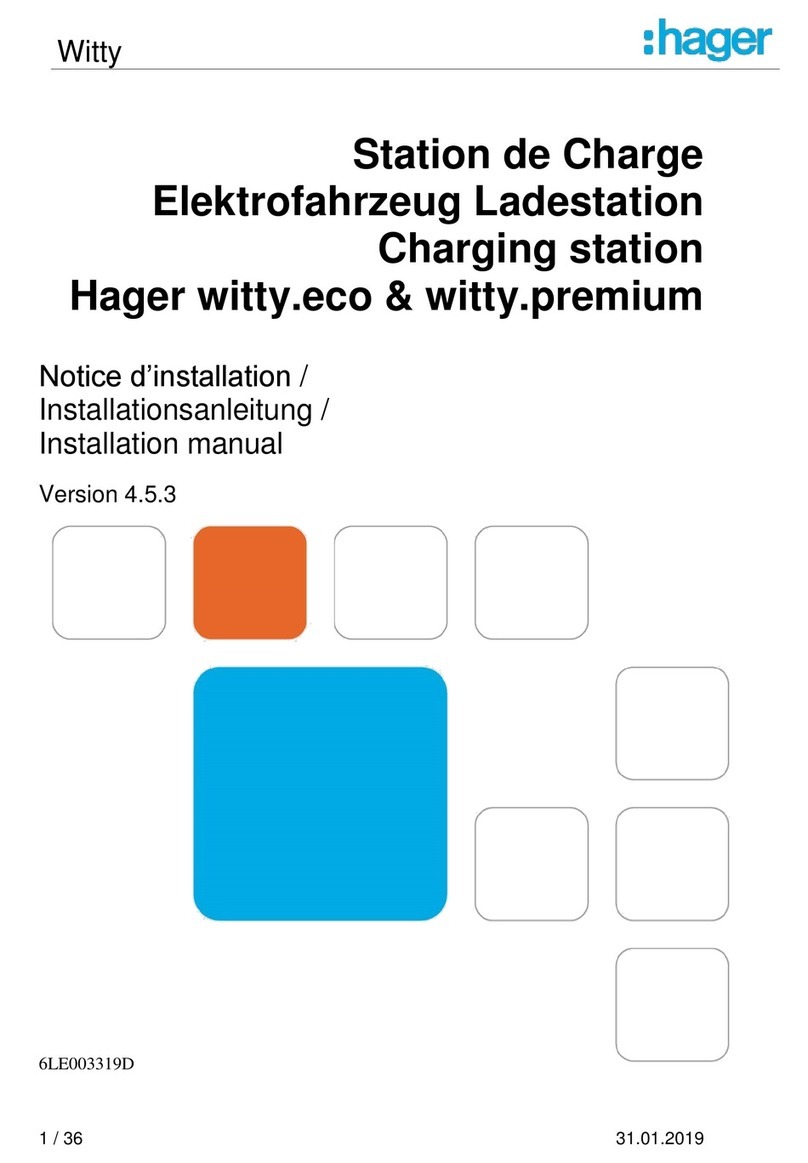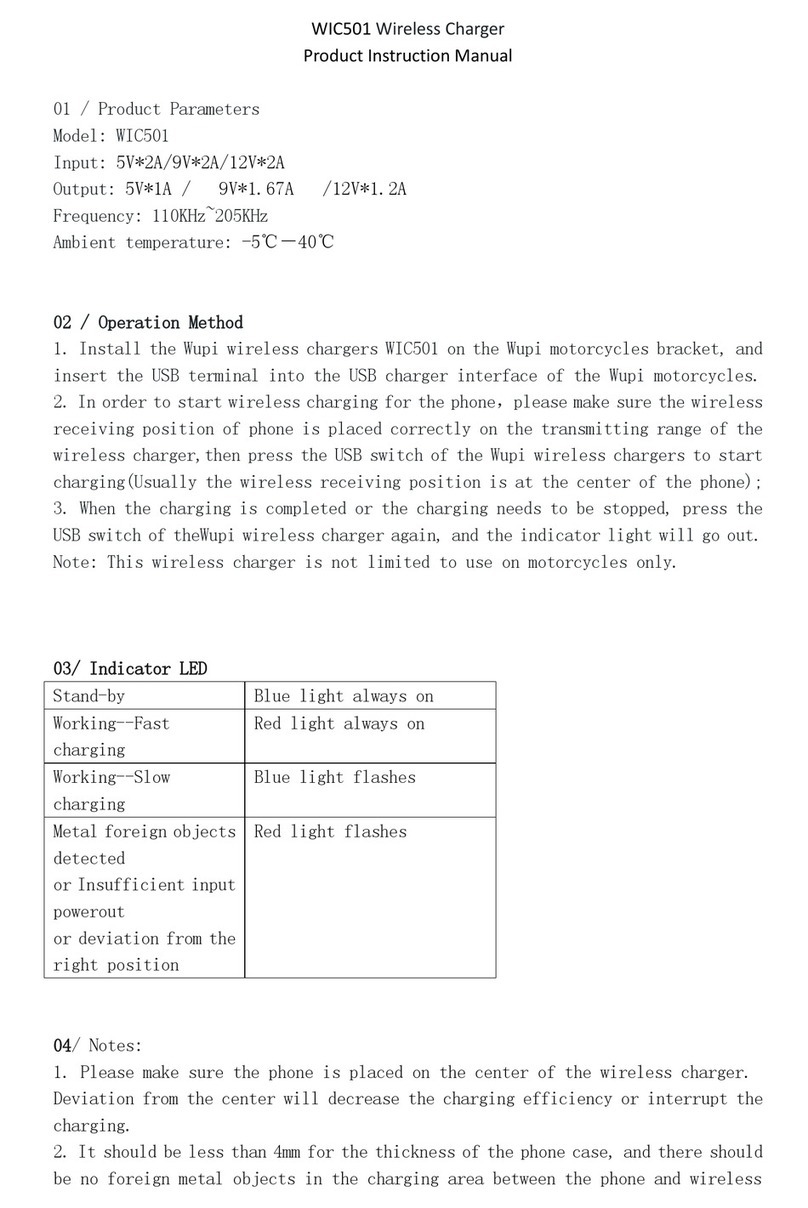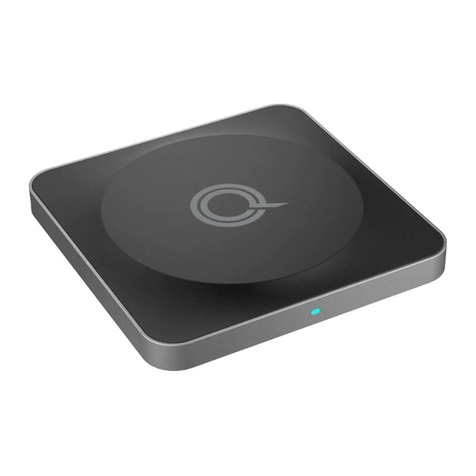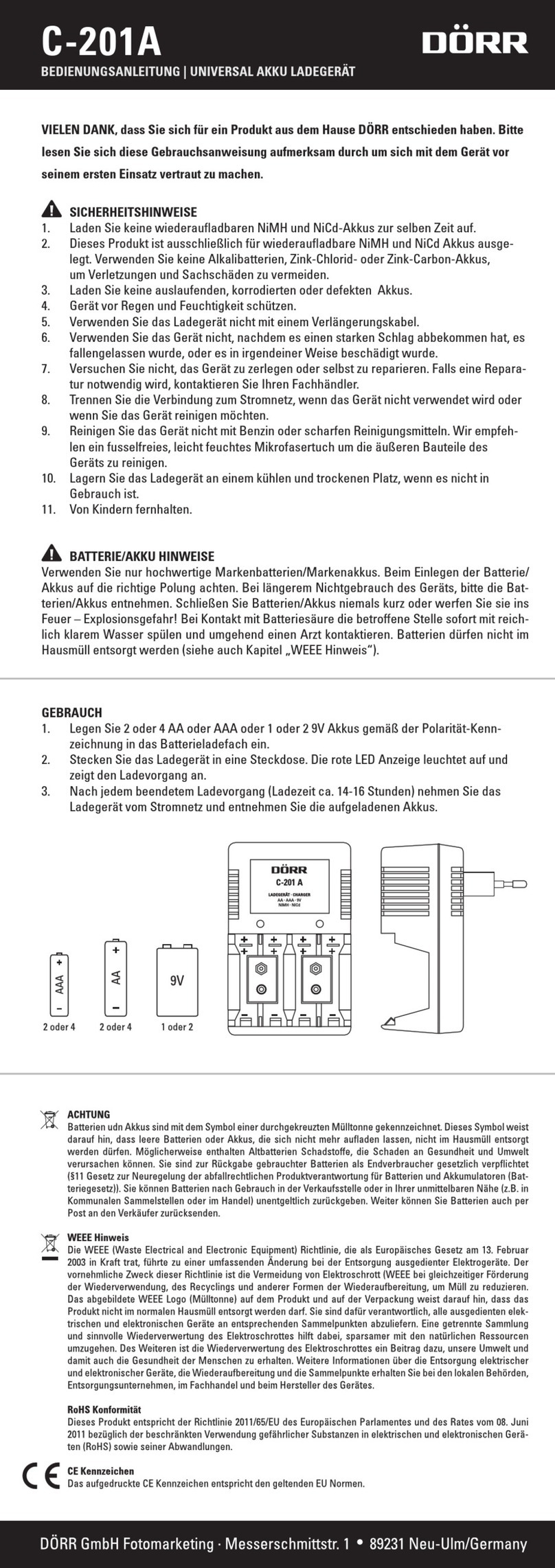Topdon Tornado1200 User manual


Welcome
About
Package List
Notice
Features
How To Use
Warranty
Important Safety Warnings
Technical Specication
Español
Deutsch
日本語
Français
Português
Italian
Polskie
3
3
3
4
4
6
17
18
21
23
44
66
87
109
130
151
Content

3
EN
English
Welcome
Thank you for purchasing TOPDON Tornado1200. Please patiently read and understand this
User Manual before operating this product. If any issues arise from the operation of this
product, you are welcome to contact [email protected] for of cial technical support.
About
TOPDON Tornado1200 serves as one of the most innovative and advanced battery charger
on the market, designed for charging all types of 6V/12V lead-acid and 12V lithium-ion
batteries, including AGM (Absorption Glass Mat), MF (Maintenance-Free), EFB (Enhanced
Flooded Battery), Gel, and LIB (Lithium Ion) batteries. In addition, being suitable for charging
battery capacities up to 80 Amp-Hours, maintaining and optimizing all battery sizes, it is quite
possibly the safest and most ef cient charger you will ever use.
Package List
TOPDON Tornado1200
Cable Clamp
User Manual
Packing Box

4 5
EN
Features
NO. Name Descriptions
2
3
4
5
Solid Blue LED indicates the charger is in Standby Mode:
not charging or providing any power to the battery.
Indicates the connected battery’s SOC (State of Charge).
Indicates the Charge Mode.
1
Solid Red LED indicates a potential error has happened.
• Press it twice to select the mode.
• Press it once to start the charging after the selection.
• Hold it for 6 seconds to start the forced charging, if the
selected battery’s voltage is < 1V.
• Press it once to end the process while charging.
Mode Button
Notice
This Product Manual is subject to change without written notice.
Read the instructions carefully and use the unit properly before operating. Failure to do so may
cause damage and/or personal injury, which will void the product warranty.

6 7
EN
How To Use
1. Before Getting Started
2. Charging Modes
Please read the battery manufacturer’s speci c precautions carefully, and have the recom-
mended rates of charge for the battery before using.
Make sure to determine the voltage and chemistry of the battery, found by referring to the
battery’s user manual before charging.
TOPDON Tornado1200 offers 5 charging modes: Standby, 12V Norm, 12V Cold AGM, 6V Norm,
and 12V Lithium.
*Note: Always check with the battery manufacturer to confi rm the right charge mode for your
specifi c battery before operating. It is important to understand the differences and purpose of
each charge mode:
Mode Explanation
• For charging 12-volt batteries in cold temperatures below
14ºF (-10ºC) or AGM batteries.
• White LED will illuminate.
• For charging 12-volt Wet Cell, Gel Cell, Enhanced Flooded,
Maintenance-Free and Calcium batteries.
• White LED will illuminate.
• Not charging or providing any power to the battery.
• Energy Save is activated, drawing microscopic power from the
electrical outlet.
• Blue LED will illuminate.
Standby
12V Norm
12V Cold/AGM
• For charging 6-volt Wet Cell, Gel Cell, Enhanced Flooded,
Maintenance-Free and Calcium batteries.
• White LED will illuminate.
6V Norm*
Mode Explanation
• For charging 12-volt lithium-ion batteries, including lithium
iron phosphate.
• White LED will illuminate.
12V Lithium**

8 9
EN
*ONLY available for 6-volt lead-acid batteries, as Wet Cell, Gel Cell, Enhanced Flooded, Mainte-
nance-Free, and Calcium batteries.
Consult the battery manufacturer before using this mode.
**ONLY available for 12-volt lithium-ion batteries, including lithium iron phosphate.
Consult the lithium battery manufacturer before charging and ask for recommended charging
rates and voltages. Lithium-ion batteries are made and constructed in different ways. Some
lithium-ion batteries may be unstable and unsuitable for charging.
3. Connecting to the Battery
The below instructions are for a negative ground system (most common).
If your vehicle is a positive ground system (uncommon), follow the below instructions in re-
verse order:
1) Connect the positive (red) battery clamp or eyelet terminal connector with the positive
battery terminal, which is typically marked by “POS, P, +”.
2) Connect the negative (black) battery clamp or eyelet terminal connector with the negative
battery terminal, which is typically marked by “NEG, N, -”, or with the vehicle chassis.
3) Connect the battery charger’s AC power plug into a suitable electrical outlet.
4) Disconnect the battery charger in the reverse sequence, removing the negative rst (or
positive rst for positive ground systems).
*Note:
• DO NOT connect the AC power plug until all other connections are made.
• DO NOT make any connections to the carburetor, fuel lines, or thin, sheet metal parts.
4. Begin Charging
1 )Verify the voltage and chemistry of the battery.
2) Con rm if the proper connection has been made between the battery clamps (eyelet ter
minal connectors) with battery terminals, and the AC power plug is plugged into the elec
trical outlet.
3) The charger will begin in Standby mode, with no power provided, indicated by a Blue LED.
4) Press the Mode button twice to toggle to the appropriate charge mode for the voltage and
chemistry of the battery. The mode LED will illuminate the selected charge mode.
5) Press it once to start charging after the selection. The charge LEDs will illuminate when
the charging process is started, depending on the health of the battery.
6) The charger can now remain connected to the battery for the needed charge.

10 11
EN
5. Understanding Charge LEDs
LED Explanation
• When the battery is >50%, and <75% charged, the 75% White
LED will slowly flash.
• When the battery is 75% charged, the 75% White LED will
become solid too.
• When the battery is >75%, and <100% charged, the 100%
White LED will slowly flash.
• When the battery is 100% fully charged, the 100% White LED
will become solid too.
• When the battery is >25%, and <50% charged, the 50% White
LED will slowly flash.
• When the battery is 50% charged, the 50% White LED will
become solid too.
• When the battery is <25% charged, the 25% White LED will
slowly flash.
• When the battery is 25% charged, the 25% White LED will
become solid.
25% White LED
50% White LED
75% White LED
100% White LED
Mode Descriptions
• During maintenance charging, the 100% Charge LED will slowly flash.
• When the battery is topped off and fully charged again, the 100%
Charge LED will turn solid White. The charger can be left connected to
the battery at all times.
Maintenance
White LED
6. Understanding Advanced Diagnostics
The will illuminate, indicating a potential error has occurred. See the following chart to iden-
tify the issue:

12 13
EN
Error Reason Solution
Wrong charging mode selection
The battery’s voltage might be too low
Check the charging mode.
Check the battery voltage
The domestic power supply’s
voltage might not match
Check your voltage of domestic
power supply
Possible short circuit Check the battery, or contact battery
manufacturer.
Reverse polarity
Solid
Error
LED
Cannot hold a charge
Reverse the battery connections.
Check the battery connections, or
contact battery manufacturer.
7. Charging Steps

14 15
EN
1) Battery Analysis & Diagnosis
2) Battery Desulphation
3) Soft Start
4) Battery Initialization
5) Battery Bulk Charge
Check the battery’s initial condition, including voltage, state-of-charge (SOC), and health,
to determine if the battery is stable before charging.
Use voltage or high-frequency pulses to break down the sulfates that have built up over
time in your aging battery, to extend battery life, and optimize battery performance.
Minimize the large startup currents from flowing when the input power is rst applied, to
avoid stressing the components by the sudden current or voltage surges.
Start the charging process with a gentle (soft) charge.
Begin the Bulk charging process based on the condition of the battery, and return 80% of
the battery’s capacity.
6) Absorption Mode
7) Battery Recondition
8) Battery Optimization
9) Battery Float Charge
10) Battery Restart Charge
Bring the charge level to 90% by delivering small amounts of current to provide a safe,
ef cient charge. This limits battery gassing and is essential to prolonging battery life.
Check the battery status, and then recover the small current to improve the
battery capacity.
Finalize the charging process, and bring the battery to maximum capacity.
In this step, the charger utilizes multi-layered charging pro les to fully recapture battery
capacity, and optimize the speci c gravity of the battery for increased run time and per-
formance.
Maintain the battery fully charged, without boiling out electrolyte or overcharging, so as
to elongate the battery life.
Restart the charging process to maintain the maximum capacity, once the battery capac-
ity is <85%.

16 17
EN
8. Charging Times
The size of the battery (Ah), the depth of discharge (DOD), and the environment temperature
will affect the charging time. Actual data may differ due to battery conditions. T1A has a ther-
mal compensation function, which can automatically adjust the charging curve to maximize
the charging performance.
The estimated time to charge a battery is shown below:
Battery Size
Ah 6V 12V
Approx. Time to Charge In Hours
32.72 hrs
43.63 hrs
32.72 hrs
43.63 hrs
16.36 hrs 16.36 hrs
10
30
60
80
5.45 hrs 5.45 hrs
*Note:
• The charge time is based on an average depth of discharge to a fully charged battery and is
for reference purposes only.
• The time to charge a normally discharged battery is based on a 50% Depth of
Discharge (DOD).
Warranty
TOPDON Three Year Limited Warranty
The TOPDON Company warrants to its original purchaser that TOPDON products will be
free from defects in material and workmanship for 36 months from the date of purchase
(Warranty Period). For the defects reported during the Warranty Period, TOPDON will,
according to the technical support analysis and con rmation, either repair or replace the
defective part or product.
Misused, disassembled, altered, or repaired by a non-TOPDON technical repair specialist.
Careless handling and violation of operation.
This limited warranty is void under the following conditions:

18 19
EN
Important Safety Warnings
Please read all safety instructions before using the product. Failure to follow these safety in-
structions may result in electric shock, explosion, or re, which may result in serious personal
injury, death, or property damage.
Someone should be around, or be within your sound range, to help you in case of an emer-
gency.
Have clean water and soap at hand in case there is contamination from the battery acid.
Wear protective goggles and appropriate clothing when working near the battery.
Always wash hands after handling batteries and related materials.
DO NOT handle or wear any metal objects, including tools, watches or jewelry etc. while op-
erating. Sparks or short circuits may occur if a metal object is dropped on the battery.
Adults need to offer detailed instructions and warnings to minors who handle this product
before use. Otherwise, the adult shall bear full responsibility and shall NOT claim compen-
sation from TOPDON for any accidents caused by the use or abuse from minors using this
product.
DO NOT use the product if it is damaged under the severe impact, or the shell / cable is broken.
DO NOT use the product if the power outlet is loose.
DO NOT use the product near the water. Store and operate the product in a dry place.
DO NOT use the product if it is soaked with water to avoid the potential damage to the
product due to the humidity and liquid. If the product is already wet and working, discon-
nect it from the power outlet, and stop using it immediately.
DO NOT disconnect the product from the power outlet by pulling the AC cable.
DO NOT attempt to change, modify or repair any part of the product, which may result in
personal injury, death, or property damage.
Any changes to the product will invalidate your warranty. Please contact TOPDON if the
product is damaged.
TOPDON shall not bear any responsibility for product damage and personal safety prob-
lems caused by the use of accessories that are not approved by TOPDON.
Using an improper extension cable may cause re and electric shock, which may result in
personal injury, death, or equipment and property damage. Please ensure: (1) the number,
size, and shape of the pins on the extension cable plug are the same as the number, size
and shape of the AC power cable of the product; (2) the extension cable is in good condi-
tion, and is correctly connected while using the extension cable.
DO NOT place the product directly above the battery, otherwise, the gas in the battery will
cause corrosion and damage.
DO NOT place the battery directly above the product, otherwise, it may cause the accidental
damage by moving car parts (including the hood and doors), moving engine parts (including
fan blades, belts and pulleys), or result in the risk of human injury or death.

20 21
EN
DO NOT use the product in an enclosed area or an area with limited ventilation.
Please operate the product at an ambient temperature of 14°F to 104°F (-10° to 40°C), and
store the product at a temperature of 0° to 130°F (-17°C to 54°C).
DO NOT charge a frozen battery. Discontinue the use of the product immediately if the bat-
tery becomes excessively warm.
DO NOT use or store the product in an area with high dust concentration.
Please store the charger in a flat place to avoid falling.
The charger is only compatible with lead-acid and lithium-ion batteries.
DO NOT use the product to charge any other type of battery. The product is ONLY compati-
ble with lead-acid and lithium-ion batteries. Charging other battery chemistries may result
in injury, death, or property damage.
Please turn off the power before any maintenance or cleaning proceeds. If the product
contacts with liquid or any type of contaminants, clean the product immediately. Use a soft
lint-free cloth (micro ber) to keep the ports from moisture.
DO NOT operate the product in areas where there is a potential explosion hazard, includ-
ing areas that are fueled or contain chemicals or particles (such as grain, dust, or metal
powder).
The design, testing, and manufacturing of the product are in compliance with regulations
regarding radio frequency emissions. Such radiation emitted by the product may have a
negative impact on the operation of other electronic devices, causing them to malfunction.
Technical Specifi cation
Input Voltage AC
Working Voltage AC
Ef ciency
Power
Charging Voltage
Charging Current
Low-Voltage Detection
Back Current Drain
Working Temp.
100-240VAC, 50-60Hz
100-240VAC, 50-60Hz
85% Approx.
25W Max
Various
1.2A (12V)
1.2A (6V)
1V(12V), 1V(6V)
< 5mA
14°F to 104°F (-10° to 40°C)

22
Storage Temp.
Charger Type
Type of Batteries
Battery Chemistries
Battery Capacity
Housing Protection
Cooling
Dimensions
Weight
0° to 130°F (-17°C to 54°C)
10 Step, Smart Charger
6V & 12V
Wet, Gel, MF, CA, EFB, AGM & LIB
Up to 80Ah (6V & 12V)
Maintains All Sizes
IP65
Natural Convection
172*71.7*39.6 mm(6.8*2.8*1.6 inches)
465g
Español

24 25
ESDE
Bienvenido
Gracias por comprar el cargador de batería de plomo-ácido TOPDON Tornado1200 (T1A).
Por favor, lea cuidadosamente y comprenda este Manual del Usuario antes de utilizar este
producto. Si surge algún problema con el funcionamiento de este producto, puede ponerse en
contacto con [email protected] para obtener asistencia técnica o cial.
Acerca
TOPDON Tornado1200 sirve como uno de los cargadores de batería más innovadores y
avanzados en el mercado, diseñado para cargar todo tipo de baterías de plomo-ácido de
6V/12V y de iones de litio de 12 V, incluidas Celdas húmedas (Normal inundada), Gel, MF (Libre
de mantenimiento), CA (Calcio), EFB (Batería inundada mejorada), AGM (Esteras de vidrio
de absorción) y baterías LIB (Ion de litio). Además, siendo adecuado para cargar baterías de
capacidades de hasta 80 amperios-hora, manteniendo y optimizando todos los tamaños de
batería, es posiblemente el cargador más seguro y e ciente que usted alguna vez utilizará.
Lista del paquete
TOPDON Tornado1200 Cable pinza
Manual del Usuario Caja de empaque
Descripciones del producto
Aviso
Este Manual del Producto está sujeto a cambios sin previo aviso por escrito.
Lea las instrucciones cuidadosamente y use la unidad correctamente antes de operar. De no
hacerlo puede causar daños y lesiones corporales, lo que anulará la garantía del producto.

26 27
ESDE
Número Nombre Descripciones
2
3
4
5
El LED azul jo indica que el cargador está en modo de
espera: no está cargando ni proporcionando ninguna
energía a la batería.
Indica el SOC (estado de carga) de la batería conectada.
Indica el modo de carga.
1
El LED rojo jo indica que se ha producido un posible
error.
• Presiónelo dos veces para seleccionar el modo.
• Presiónelo una vez para comenzar a cargar después
de la selección.
• Manténgalo por 6 segundos para comenzar la carga
forzada si el voltaje de la batería seleccionada es <1V.
• Presiónelo una vez para nalizar el proceso de carga.
Botón de modo
Cómo utilizar
1. Antes de comenzar
2. Modos de carga
Por favor, lea cuidadosamente las precauciones especí cas del fabricante de la batería y ten-
ga los valores de carga recomendadas para la batería antes de usarla.
Asegúrese de determinar el voltaje y la química de la batería, que se encuentra consultando el
manual del usuario de la batería antes de cargarla.
TOPDON T1A ofrece 5 modos de carga: en espera, estándar de 12 V, frío / AGM de 12 V, es-
tándar de 6 V, litio de 12 V.
* Nota: Siempre verifi que con el fabricante de la batería para confi rmar el modo de carga cor-
recto para su batería específi ca antes de operar. Es importante comprender las diferencias y
el propósito de cada modo de carga:
• No está cargando ni proporcionando ninguna energía a la batería.
• El Ahorro de Energía está activado, extrayendo energía microscópica
de la toma de corriente eléctrica.
• El LED azul se iluminará.
En espera
Modo Explicación

28 29
ESDE
Modo Explicación
• Para cargar baterías de 12 voltios en temperaturas frías por debajo
de 14ºF (-10ºC) o baterías AGM.
• El LED blanco se iluminará.
• Para cargar baterías de: celdas húmedas de 12 voltios, celdas de
gel, inundadas mejoradas, libre de mantenimiento y de calcio.
• El LED blanco se iluminará.
Estándar de 12V
Frío/AGM de 12V
• Para cargar baterías de iones de litio de 12 voltios, incluido el
fosfato de hierro y litio .
• El LED blanco se iluminará.
Litio de 12V**
• Para cargar baterías de 6 voltios de: celdas húmedas, celdas de
gel, inundadas mejoradas, libre de mantenimiento y de calcio.
• El LED blanco se iluminará.
Estándar de 6V*
* SOLO disponible para baterías de plomo-ácido de 6 voltios, como baterías de celda húmeda,
celda de gel, inundadas mejoradas, libre de mantenimiento y de calcio.
Consulte al fabricante de la batería antes de usar este modo.
** SOLO disponible para baterías de iones de litio de 12 voltios, incluido el fosfato de hierro y litio.
Consulte al fabricante de la batería de litio antes de cargar y solicite los valores y voltajes de
carga recomendados. Las baterías de iones de litio son fabricadas y construidas de diferentes
maneras. Algunas baterías de iones de litio pueden ser inestables e inadecuadas para cargar.
3. Conectando a la batería
Las siguientes instrucciones son para un sistema de tierra negativo (el más común).
Si su vehículo es un sistema de tierra positivo (poco común), siga las siguientes instrucciones
en orden inverso:
1) Conecte la pinza positiva (roja) de la batería o el conector de terminal de ojal con el ter
minal positivo de la batería, que normalmente está marcado con "POS, P, +".
2) Conecte la pinza negativa (negra) de la batería o el conector de terminal de ojal con el
terminal negativo de la batería, que normalmente está marcado con “NEG, N, -” o con el
chasis del vehículo.
3) Conecte el enchufe de alimentación de CA (corriente alterna)del cargador de batería a
una toma de corriente eléctrica adecuada.

30 31
ESDE
4) Desconecte el cargador de batería en la secuencia inversa, quitando el negativo primero (o
positivo primero para los sistemas de tierra positivos).
*Nota:
• NO conecte el enchufe de alimentación de CA (corriente alterna) hasta que se hayan real
izado todas las demás conexiones.
• NO realice ninguna conexión al carburador, a las líneas de combustible ni a las partes de
láminas de metal delgadas.
4. Comienzar a cargar
1) Veri que el voltaje y la química de la batería.
2) Con rme si ha realizado la conexión adecuada entre las pinzas de la batería (conectores
de terminal de ojal) con los terminales de la batería, y si el enchufe de alimentación de CA
está enchufado a la toma de corriente eléctrica.
3) El cargador comenzará en modo de espera, sin suministro de energía, indicado por un
LED azul.
4) Presione el botón Modo dos veces para alternar al modo de carga apropiado para el vol
taje y la química de la batería. El LED de modo iluminará el modo de carga seleccionado.
5) Presione una vez para comenzar a cargar después de la selección. Los LED de carga se
5. Comprensión de los LED de carga
LED Explanation
• Cuando la batería tiene> 25% y <50% de carga, el LED blanco
de 50% parpadeará lentamente.
• Cuando la batería está cargada al 50%, el LED blanco de 50%
también se volverá jo.
• Cuando la batería tiene <25% de carga, el LED blanco de 25%
parpadeará lentamente.
• Cuando la batería está cargada al 25%, el LED blanco de 25%
se volverá jo.
LED blanco
de 25%
LED blanco
de 50%
iluminarán cuando se inicie el proceso de carga, dependiendo del estado de salud de
la batería.
6) El cargador ahora puede permanecer conectado a la batería para la carga necesaria.

32 33
ESDE
LED Explanation
• Cuando la batería tiene> 50% y <75% de carga, el LED blanco
de 75% parpadeará lentamente.
• Cuando la batería está cargada al 75%, el LED blanco de 75%
también se volverá jo.
• Cuando la batería tiene> 75% y <100% de carga, el LED blanco
de 100% parpadeará lentamente.
• Cuando la batería está cargada al 100% por completo, el LED
blanco de 100% también se volverá jo.
LED blanco
de 75%
LED blanco
de 100%
• Durante la carga de mantenimiento, el LED de carga de 100%
parpadeará lentamente.
• Cuando la batería se acaba y se vuelve a cargar completamente, el
LED de carga de 100% se volverá un blanco jo. El cargador puede
dejarse conectado a la batería en todo momento.
LED blanco de
mantenimiento
Error Motivo Solución
Selección incorrecta del modo
de carga
El voltaje de la batería puede ser
demasiado bajo.
Veri que el modo de carga.
Veri que el voltaje de la batería
El voltaje de la fuente de alimentación
doméstica puede no coincidir
Veri que el voltaje de su fuente de
alimentación doméstica
Posible cortocircuito Veri que la batería o póngase en
contacto con el fabricante de la batería.
Polaridad inversa
LED
de
error
j o
No puede mantener una carga
Invierta las conexiones de la batería.
Veri que las conexiones de la batería o póngase
en contacto con el fabricante de la batería.
6. Comprensión de los diagnósticos avanzados
El se iluminará, indicando que se ha producido un posible error. Vea el siguiente cuadro para

34 35
ESDE
7. Pasos de carga 1) Análisis y diagnóstico de batería
2) Desulfatación de batería
3) Arranque Suave
4) Inicialización de batería
5) Carga masiva de batería
Compruebe la condición inicial de la batería, incluido el voltaje, el estado de carga y de
salud, para determinar si la batería es estable antes de cargar
Use voltaje o pulsos de alta frecuencia para descomponer los sulfatos que se han acu-
mulado con el tiempo en su batería vieja, para extender la vida útil de la batería y optimi-
zar el rendimiento de la batería.
Minimice el flujo de las grandes corrientes de arranque cuando se aplica la energía de
entrada por primera vez, para evitar estresar los componentes por el repentino aumento
de corriente o voltaje.
Comience el proceso de carga con una carga delicada (suave)
Comience el proceso de carga masiva en base al estado de la batería y devuelva el 80%
de la capacidad de la batería.

36 37
ESDE
6) 6) Modo de absorción
7) Reacondicionamiento de batería
8) Optimización de batería
9) Carga de flotación de batería
10) Carga de reinicio de batería
Lleve el nivel de carga al 90% mediante la entrega de pequeñas cantidades de corriente
para proporcionar una carga segura y e ciente. Esto limita la emisión de gases de la bat-
ería y es esencial para prolongar la vida útil de la batería.
Compruebe el estado de la batería y luego recupere la pequeña corriente para mejorar la
capacidad de la batería.
Finalice el proceso de carga y lleve la batería a su capacidad máxima.
En este paso, el cargador utiliza per les de carga de multicapas para recuperar comple-
tamente la capacidad de la batería y optimizar la gravedad especí ca de la batería para
aumentar el tiempo de funcionamiento y el rendimiento.
Mantenga la batería completamente cargada, sin hervir el electrolito o sobrecargarla,
para alargar la vida útil de la batería.
Reiniciar el proceso de carga para mantener la capacidad máxima, una vez que la capaci-
dad de la batería sea <85%.
8. Tiempos de carga
El tamaño de la batería (Ah), la profundidad de descarga (DOD) y la temperatura ambiente
afectarán el tiempo de carga. Los datos actuales pueden diferir debido a las condiciones de
la batería. T1A tiene una función de compensación térmica, la cual puede ajustar automática-
mente la curva de carga para maximizar el rendimiento de carga.
El tiempo estimado para cargar una batería se muestra a continuación:
Battery
Size
Ah 6V 12V
Approx. Time to Charge In Hours
32.72 hrs
43.63 hrs
32.72 hrs
43.63 hrs
16.36 hrs 16.36 hrs
10
30
60
80
5.45 hrs 5.45 hrs
Table of contents
Languages:
Other Topdon Batteries Charger manuals
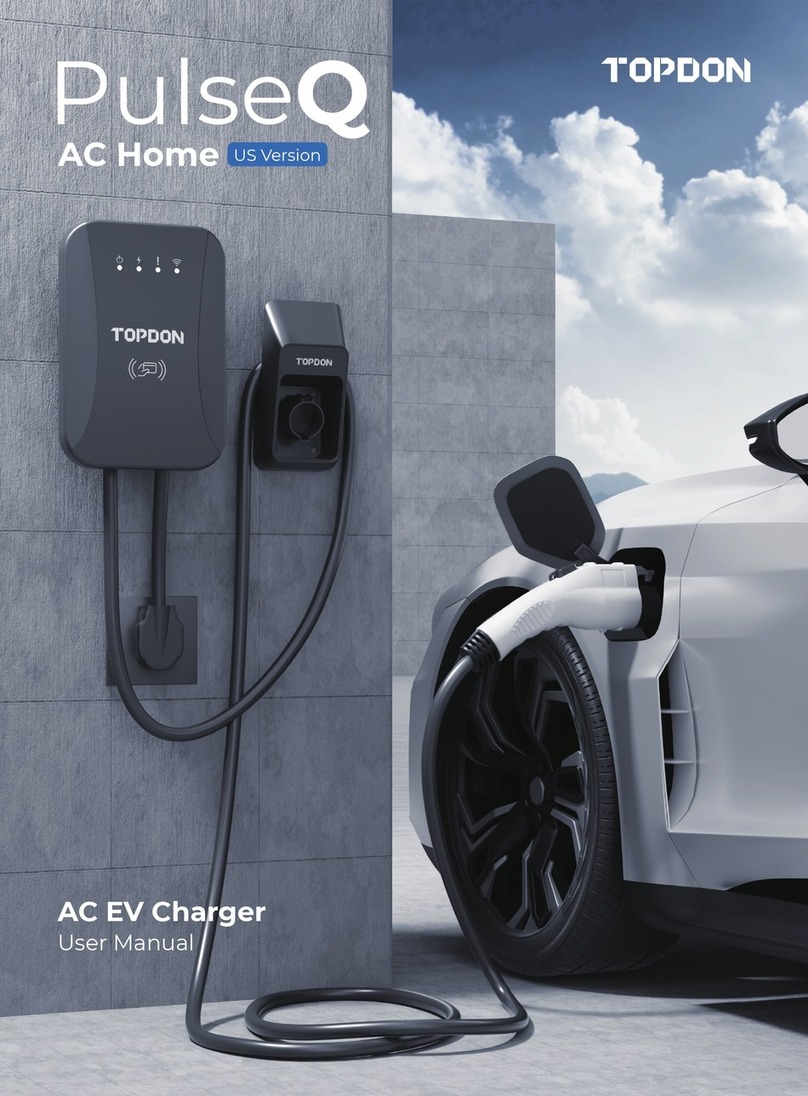
Topdon
Topdon PulseQ AC Home US Version User manual
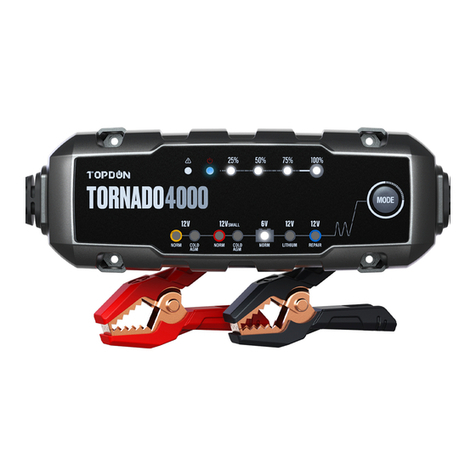
Topdon
Topdon Tornado4000 User manual

Topdon
Topdon TORNADO 90000 User manual
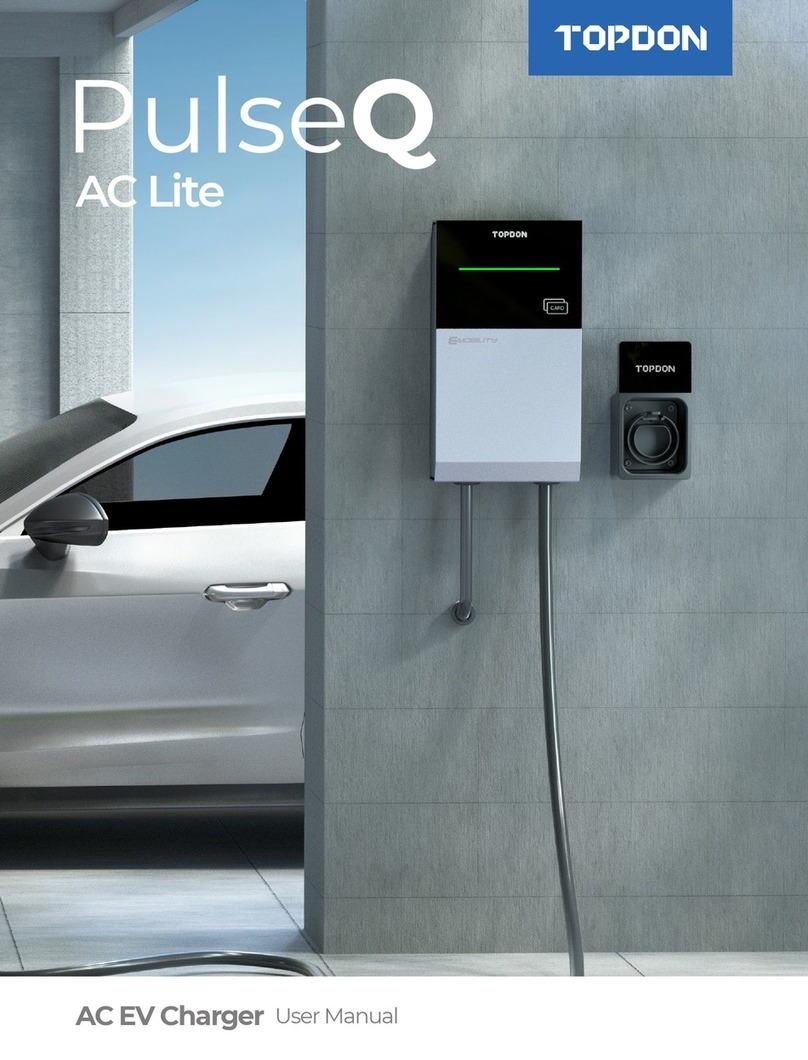
Topdon
Topdon PulseQ AC Lite User manual
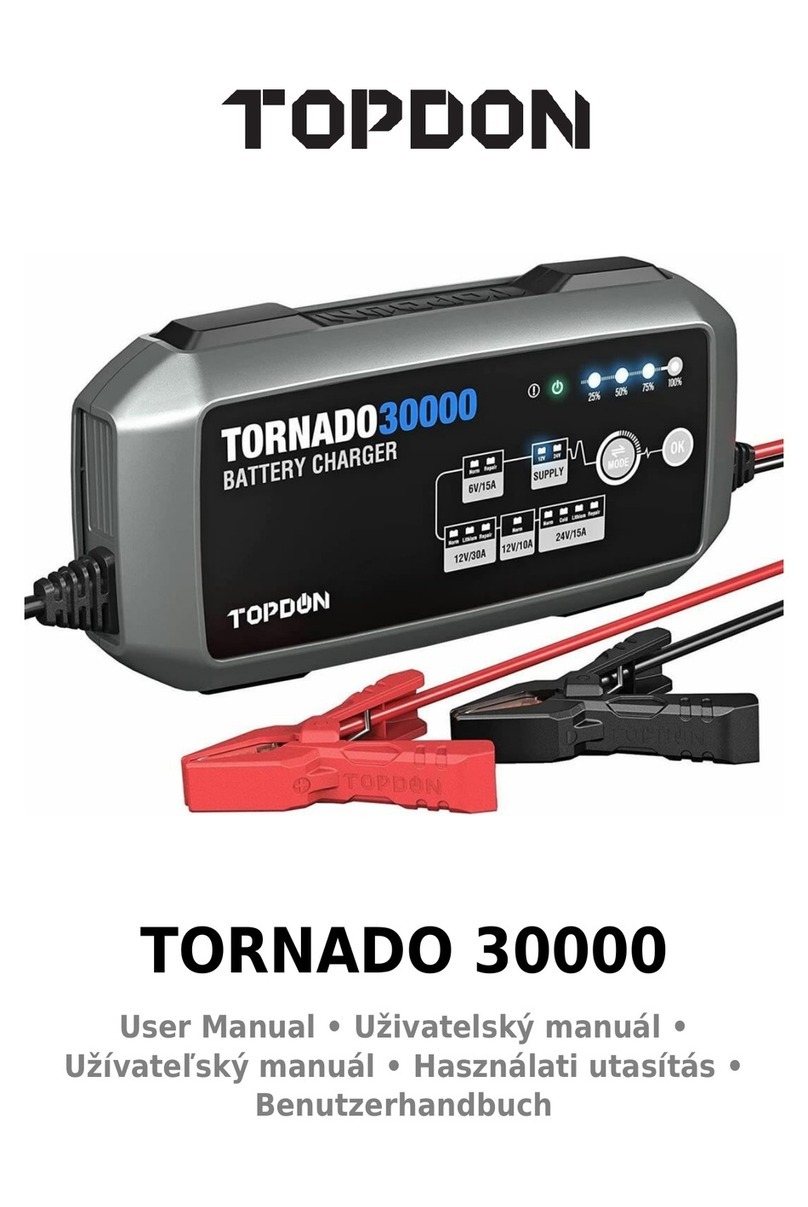
Topdon
Topdon Tornado 30000 User manual
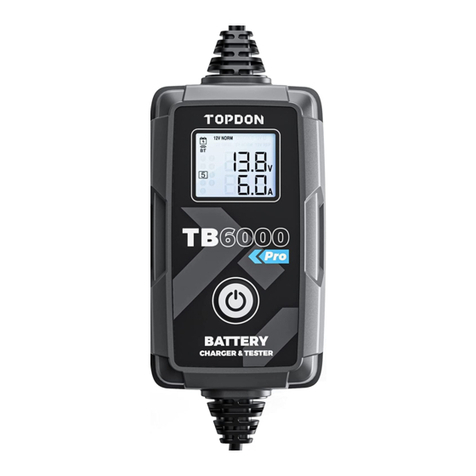
Topdon
Topdon TB6000Pro User manual

Topdon
Topdon Tornado 30000 User manual

Topdon
Topdon TB8000 User manual

Topdon
Topdon TB6000Pro User manual

Topdon
Topdon Tornado4000 User manual
